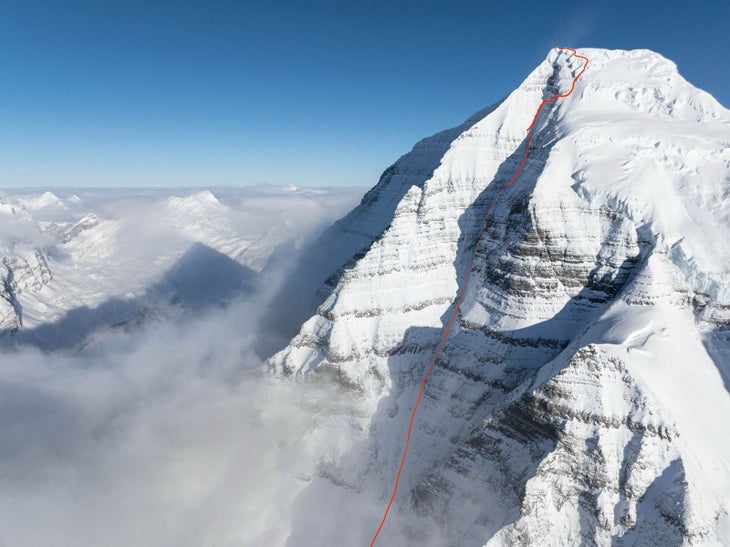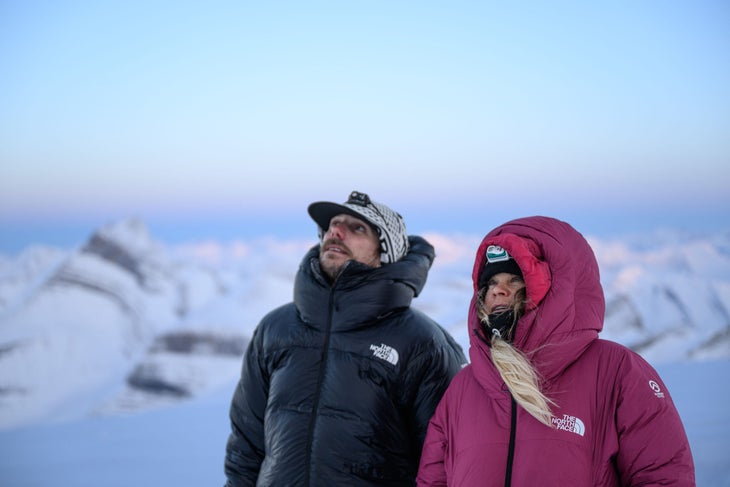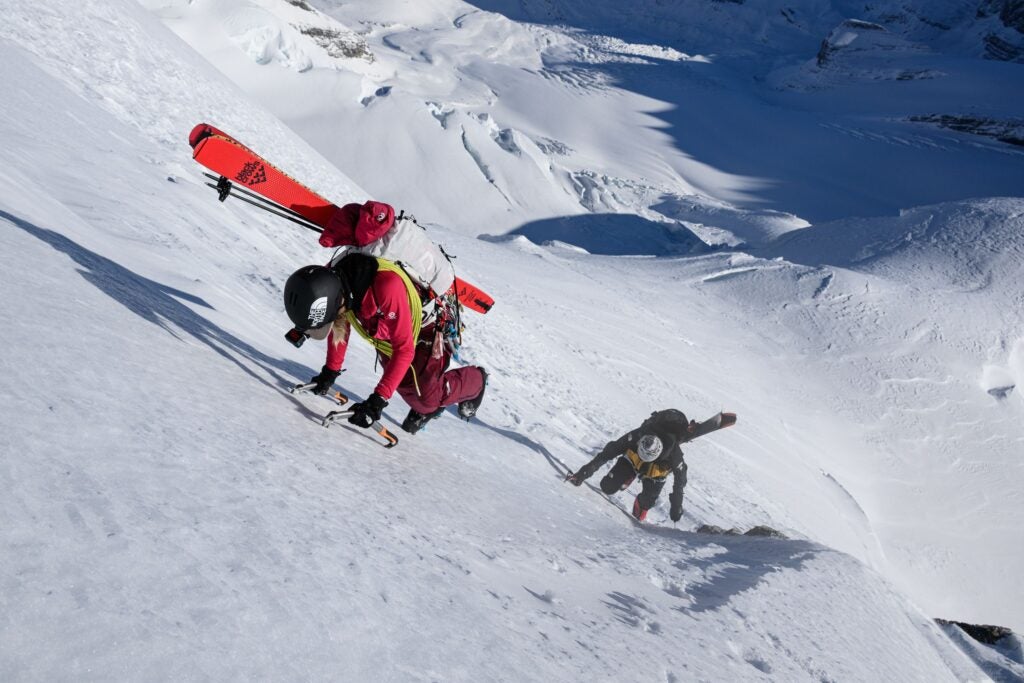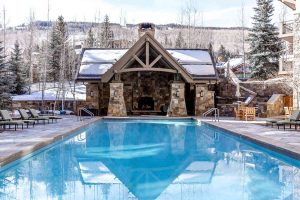The sun was setting over the South Face of 12,972-foot Mount Robson, the highest peak in the Canadian Rockies, when Canadian professional ski mountaineer Christina “Lusti” Lustenberger and Chamonix-based IFMGA guide Guillaume “Gee” Pierrel decided bail on their climb.
The two were attempting a first descent of the peak’s Great Couloir on February 13, and were just 650 feet shy of the summit when they decided to turn around.
“At that point we thought ‘Oh my God, future me would wanna go back, but I need a break from this.’” Lustenberger told Outside.
Lustenberger and Pierrel, hot on the heels of their astounding set of first descents on New Zealand’s 12,218-foot Mount Cook, were attempting to put their stamp on a face that has tested mountaineering greats for generations. Famed Canadian alpinist Barry Blanchard established a route called “Infinite Patience” on the mountain’s Emperor Face 2002, and in 2016, the late Marc-André Leclerc climbed that route solo.
Canadians Ptor Spricenieks and Troy Jungen skied the first descent of the peak in 1995, a line that would later enter the book 50 Classic Ski Descents in North America. The mountain has only been skied once since, by Dylan Cunninghman in 2017.
“Robson holds the names of so many legends of skiing and climbing,” Lustenberger said. “It’s iconic in so many ways and for Gee and I to put our names up there with those greats is incredibly meaningful.”

Lustenberger and Pierrel’s descent on that first attempt would prove to be much more difficult than the climb. The skiers had to reverse several pitches of mixed rock and ice climbing, ski some of the worst snow they’d ever encountered, and rig seven rappels through sections of decaying sedimentary rock and vertical ice—all in the dark.
The pair began their first attempt on February 13, and had attempted to climb the south face over two days, setting up camp halfway up the mountain while temperatures dropped below minus-13 degrees Fahrenheit.
On the way down, they packed up their camp and descended carefully. The Great Couloir is shaped like a giant funnel, and the further Lustenberger and Pierrel descended, the greater the risk that falling rock and ice could injure or kill them. The two ski mountaineers exited the lower gully through a section of trees so tight they had to remove their skis. They finally returned to their motor home at 10 P.M.
“On that first attempt, the snow was so bad,” Pierrel told Outside. “Hard, icy, all the stuff fell down the chute that day made little bumps and waves. The skiing was terrible.”
After regrouping in the nearby town of Valemount for a few days, Lustenberger and Pierrel returned to Mount Robson with a film crew. The team flew to the east side of the mountain and began climbing the Kain Route, a world-famous alpine climb, on February 15.
It had snowed during their break in Valemount, and conditions were much better for skiing when they returned. “Mt. Robson creates its own weather system,” Lustenberger said.
The skiers set out in sub-zero temperatures—ideal for keeping the rock and snow glued into place. “That’s why I invited Gee to come in February,” she said. “Robson has such a big South Face that we wanted to limit solar radiation. The sun is so intense in March that it would shed. Earlier than February, the days are too short.”
Luckily, the snow didn’t hide the rappel anchors the duo had placed on their first attempt a few days prior, which sped up their descent from the summit. This proved to be key for their safety in The Great Colouir.
“It’s like playing Russian Roulette, a game of chance,” said Pierrel. “We called the lower part of the descent the Cascade. You’re funneled through these little gullies. We can control how fast we move through those gullies but not what comes down on our heads.”
In recent years, Lustenberger has skied lines that have previous ski mountaineers haven’t even considered—Robson, Cook, the Great Trango Tower. These ski lines are essentially ice climbing routes that Lustenberger has descended on skis.
Outside asked her and Pierrel how they approach these routes, given the increasing danger around each objective.
“When you step into that line you’re accepting a huge amount of consequences that you can’t control,” said Lustenberger. “I think that’s part of being in the mountains. But I felt like Mount Robson was an important part of my vision and journey. It was something I felt viscerally compelled to do.”

Lustenberger said she’s assessed the south face of Mount Robson for a decade. “I decided to go this season because my requirements lined up. After skiing with Gee in New Zealand, I knew I had a partner that I trust completely and move really well with in the mountains,” Lustenberger said.
Pierrel is a guide, and he is accustomed to operating with much wider margins of safety. “This was so far from the style of risk management I often use in the mountains as a guide,” he said. “At one point I said ‘I’m too old for this shit, I’m not made of iron like you Lusti.’”
Pierrel said that by the end of the descent he was physically and mentally exhausted from the stress of being exposed to falling rock and ice. “Personally, I pushed pretty close to the maximum,” he added.
On February 16, after their painfully close attempt three days prior, the two ski mountaineers reached the summit and then carved their signatures down the South Face of the Rockies’ most formidable peak.
“Robson is the King of the Rockies,” Lustenberger said. “It’s elevation relief and scope is real, Himalayan-style terrain sitting in the Canadian Rockies. I am so relieved to be on the other side of this project. It’s been a dream in the making, one I had thought about for years. My ski partner Gee was a force and we worked hard as a team. Constantly pushing ourselves and each other to another level.”
Their film about the expedition, produced by production company Sherpa Cinemas, will come out in late 2025. As for what’s next? Pierrel hinted his interest in attempting to ski Mount Everest’s Hornbein Couloir, a line he describes as extremely similar to Robson’s Great Couloir—if it sat on the Roof of the World.
But first, both skiers told Outside they needed a relaxing trip to the sauna.








